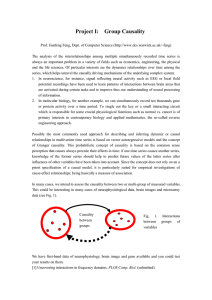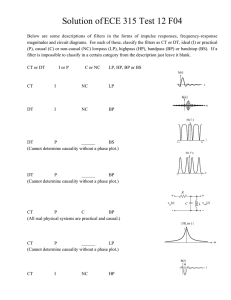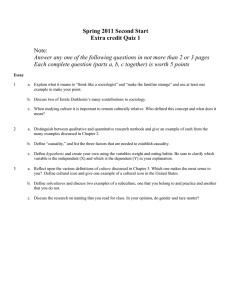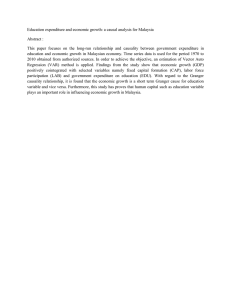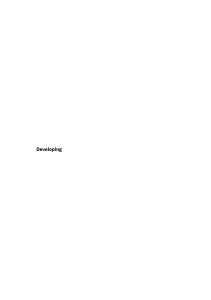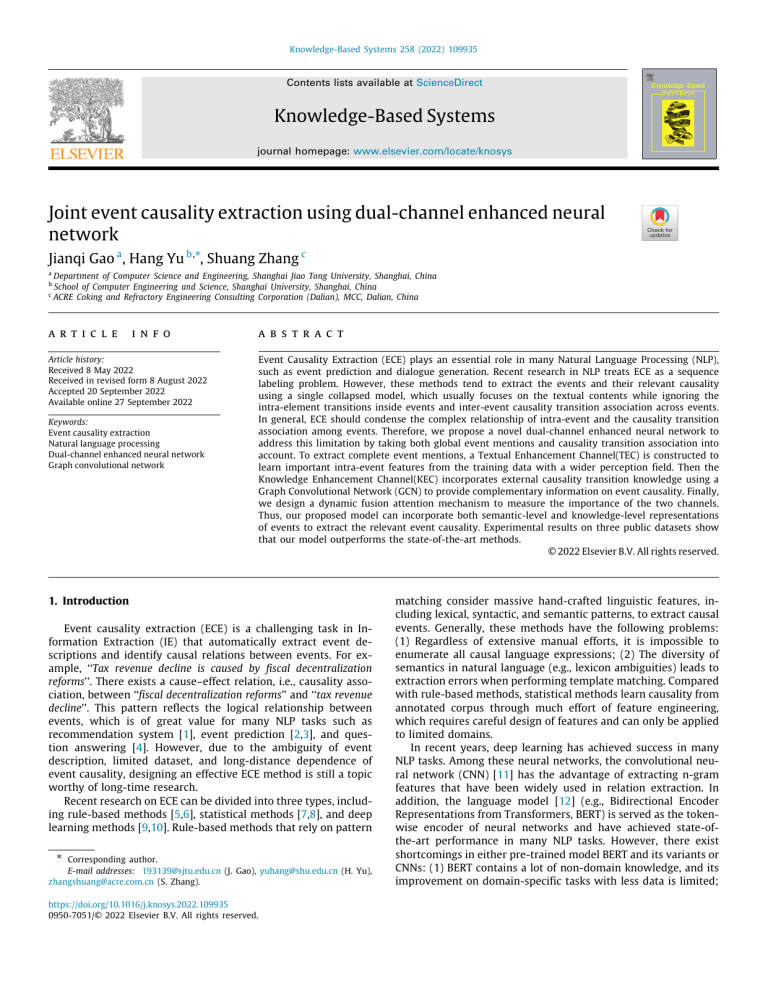
Knowledge-Based Systems 258 (2022) 109935
Contents lists available at ScienceDirect
Knowledge-Based Systems
journal homepage: www.elsevier.com/locate/knosys
Joint event causality extraction using dual-channel enhanced neural
network
∗
Jianqi Gao a , Hang Yu b , , Shuang Zhang c
a
Department of Computer Science and Engineering, Shanghai Jiao Tong University, Shanghai, China
School of Computer Engineering and Science, Shanghai University, Shanghai, China
c
ACRE Coking and Refractory Engineering Consulting Corporation (Dalian), MCC, Dalian, China
b
article
info
Article history:
Received 8 May 2022
Received in revised form 8 August 2022
Accepted 20 September 2022
Available online 27 September 2022
Keywords:
Event causality extraction
Natural language processing
Dual-channel enhanced neural network
Graph convolutional network
a b s t r a c t
Event Causality Extraction (ECE) plays an essential role in many Natural Language Processing (NLP),
such as event prediction and dialogue generation. Recent research in NLP treats ECE as a sequence
labeling problem. However, these methods tend to extract the events and their relevant causality
using a single collapsed model, which usually focuses on the textual contents while ignoring the
intra-element transitions inside events and inter-event causality transition association across events.
In general, ECE should condense the complex relationship of intra-event and the causality transition
association among events. Therefore, we propose a novel dual-channel enhanced neural network to
address this limitation by taking both global event mentions and causality transition association into
account. To extract complete event mentions, a Textual Enhancement Channel(TEC) is constructed to
learn important intra-event features from the training data with a wider perception field. Then the
Knowledge Enhancement Channel(KEC) incorporates external causality transition knowledge using a
Graph Convolutional Network (GCN) to provide complementary information on event causality. Finally,
we design a dynamic fusion attention mechanism to measure the importance of the two channels.
Thus, our proposed model can incorporate both semantic-level and knowledge-level representations
of events to extract the relevant event causality. Experimental results on three public datasets show
that our model outperforms the state-of-the-art methods.
© 2022 Elsevier B.V. All rights reserved.
1. Introduction
Event causality extraction (ECE) is a challenging task in Information Extraction (IE) that automatically extract event descriptions and identify causal relations between events. For example, ‘‘Tax revenue decline is caused by fiscal decentralization
reforms’’. There exists a cause–effect relation, i.e., causality association, between ‘‘fiscal decentralization reforms’’ and ‘‘tax revenue
decline’’. This pattern reflects the logical relationship between
events, which is of great value for many NLP tasks such as
recommendation system [1], event prediction [2,3], and question answering [4]. However, due to the ambiguity of event
description, limited dataset, and long-distance dependence of
event causality, designing an effective ECE method is still a topic
worthy of long-time research.
Recent research on ECE can be divided into three types, including rule-based methods [5,6], statistical methods [7,8], and deep
learning methods [9,10]. Rule-based methods that rely on pattern
∗ Corresponding author.
E-mail addresses: 193139@sjtu.edu.cn (J. Gao), yuhang@shu.edu.cn (H. Yu),
zhangshuang@acre.com.cn (S. Zhang).
https://doi.org/10.1016/j.knosys.2022.109935
0950-7051/© 2022 Elsevier B.V. All rights reserved.
matching consider massive hand-crafted linguistic features, including lexical, syntactic, and semantic patterns, to extract causal
events. Generally, these methods have the following problems:
(1) Regardless of extensive manual efforts, it is impossible to
enumerate all causal language expressions; (2) The diversity of
semantics in natural language (e.g., lexicon ambiguities) leads to
extraction errors when performing template matching. Compared
with rule-based methods, statistical methods learn causality from
annotated corpus through much effort of feature engineering,
which requires careful design of features and can only be applied
to limited domains.
In recent years, deep learning has achieved success in many
NLP tasks. Among these neural networks, the convolutional neural network (CNN) [11] has the advantage of extracting n-gram
features that have been widely used in relation extraction. In
addition, the language model [12] (e.g., Bidirectional Encoder
Representations from Transformers, BERT) is served as the tokenwise encoder of neural networks and have achieved state-ofthe-art performance in many NLP tasks. However, there exist
shortcomings in either pre-trained model BERT and its variants or
CNNs: (1) BERT contains a lot of non-domain knowledge, and its
improvement on domain-specific tasks with less data is limited;
J. Gao, H. Yu and S. Zhang
Knowledge-Based Systems 258 (2022) 109935
Fig. 1. Overview of dual-channel enhanced neural network.
(2) CNN can only extract local n-gram features of text, its ability
to perceive context is limited; (3) Deep models are prone to
overfit on insufficient datasets; (4) Due to the ambiguity of event
mentions and the long-distance dependence of cause and effect,
it is difficult for the model to extract complete event causality
just relying on the model itself and limited annotated dataset.
To solve the above four problems, we propose a novel dualchannel enhanced neural network for ECE. As shown in Fig. 1,
our proposal combines event semantics learned from the text
and causality transition among events obtained from a Causality
Transition Graph (CTG). To utilize global textual context and CTG,
we design a dual-channel enhancement architecture to leverage
multiple sources, such as textual description and graph structure,
to generate rich-attribute embeddings for events, simultaneously
encapsulating causality relations. First, the pre-trained model
BERT is applied to generate the token-wise representations for
the input sentence. Then, above the BERT encoder, the Textual
Enhancement Channel (TEC) passes the hidden representations
into an iterated dilated convolution neural network to encode
the global textual information. However, differing from previous
works [13], we learn the probability distribution of n-grams from
the training data using Naive Bayes and initialize the convolutional kernel with centroid vectors of the cause/effect n-gram
clusters before the fine-tuning procedure. In parallel with TEC,
we design another Knowledge Enhancement Channel (KEC) by
constructing a CTG from a causal corpus using causal indicators
to integrate event causality transition associations. Finally, to
enhance the model’s ability to identify the complex causality
transition of inter-event in the sentence, we use the attention
mechanism to link the representation of TEC and KEC together.
The contributions of the paper are four folds:
• Experiments conducted on three datasets demonstrate that
the dual-channel enhancement strategies are interrelated
and effective, and achieve state-of-the-art performance on
both in-domain and out-domain datasets.
2. Related work
ECE can be divided into template matching, statistical learning,
and neural networks. In this section, we will briefly introduce the
three parts.
2.1. Template matching on ECE
ECE based on template matching uses causal indicators to
construct adaptive semantic templates and extract causal events
from text. Khoo et al. [5] apply adaptive templates and linguistic
clues to ECE. Girju et al. [6] obtain lexical patterns that can express causality from knowledge bases such as WordNet, and sort
the obtained patterns through the coarse-grained semantic constraints. To reduce manual participation, Ittoo et al. [14] extract
complex causal relations from domain texts through a minimally
supervised algorithm without relying on manual rules. However,
template matching requires a lot of manpower to carefully design
the template, and the accuracy and generalization of the template
matching still need to be improved.
2.2. Statistical learning on ECE
Methods of statistical learning turn ECE into a classification
task. Inui et al. [7] propose a computational model for ECE,
which can extract four types of event causality, including cause,
effect, precondition, and means. Blanco et al. [8] further present a
supervised method to extract causality from open domain texts.
However, the above model can only deal with explicit causality,
and the accuracy of implicit causality extraction is low. To solve
this problem, Yang et al. [15] develop an ECE system that is able to
extract more complex causal relations between two noun phrases
represented by fixed verbs or prepositions. However, extensive
feature engineering and possible noise reduce the accuracy and
applicability of the model.
• We propose a dual-channel enhanced model that integrates
knowledge obtained from labeled data and domain unstructured text into the model, which can fully consider intraelement transitions inside events and inter-event causality
transition association across events.
• We propose a TEC to enhance event extraction on cause and
effect by integrating the important n-gram filters learned
from labeled data into iterated dilated convolutions, capturing semantic features inside events with global contextual
information.
• We propose an effective method to construct KEC incorporating causality transition associations obtained from CTG,
which can improve the model’s ability to identify complex
causal relationships between events.
2.3. Neural networks on ECE
In recent years, deep learning has become the mainstream
method of natural language processing, among which the most
widely used are Recursive Neural Networks (RNN) [16,17] and
2
J. Gao, H. Yu and S. Zhang
Knowledge-Based Systems 258 (2022) 109935
Fig. 2. Example of event causality extraction, the description of cause and effect are extracted at once.
neural network to a graph. Then Defferrard et al. [32] use Chebyshev polynomials to obtain graph convolution to remove expensive Laplacian eigen-decomposition. Based on previous work [31,
32], Kipf et al. [33] further simplify spectral graph convolutions
via a localized first-order approximation. Recently, people have
done a lot of research on the application of graph neural networks
on NLP, such as text classification [34], event argument extraction [35], document-level graphs for relation extraction [36], and
document-level graphs for event causality identification [37].
Convolutional Neural Networks (CNN) [18,19]. Socher et al. [20]
present a method for relation classification using a recursive
neural network. To represent relations more compactly, Ebrahimi
et al. [21] use RNN for relation classification based on the shortest
path of two entities in the dependency graph. However, RNNbased methods require dependency analysis which may introduce
error propagation.
CNN can automatically extract n-gram semantic features from
the text and has been proven suitable for ECE due to its excellent
local feature extraction and discriminative representation capabilities [11,22]. Furthermore, Santos et al. [23] propose a ranking
CNN algorithm for relation classification, and reduce the influence
of artificial classes on experimental results. However, the last
layer of neurons in the convolution of conventional CNN models
can only obtain a small piece of information in the original input
data. Since the contextual information in the text may affect the
label of the input text, the perceptual field of CNN needs to be
further improved. To solve this problem, Yu et al. [24] propose
dilated convolutions to increase the perception field of the filter.
Since increasing the depth of the dilated convolution on limited
data can easily lead to overfitting, Strubell et al. [25] propose
an improved method called Iterated Dilated Convolutional Neural
Network (IDCNN), which greatly increases the perception range
and stability of the model by using a recursive approach. For
ECE, Liang et al. [26] propose a novel multi-level causality detection network to detect text with event causality by combining
the advantages of feature engineering in providing prior knowledge and neural networks in capturing contextual information.
Furthermore, Jin et al. [9] propose a cascaded multi-structure
neural network to improve the accuracy of inter-sentence and
implicit causality extraction. However, due to complex of ECE,
just relying on a small amount of labeled data and the model
itself, the improvement of ECE is limited. In response, Wang
et al. [10] propose a join extraction framework to incorporate the
prior knowledge like frequent event causality mentioned into the
convolution kernel. Li et al. [27] incorporate multiple knowledge
into the embedding representation to generate hybrid embedding
representations. Besides, Li et al. [13] obtain causal knowledge
from labeled data and external knowledge bases such as WordNet
and FrameNet, respectively, and integrate it into the convolution
initialization, which improves the overall performance of the
model on the ECE task.
3. The proposed approach
In this section, we will introduce our model architecture as
shown in Fig. 1. For both the textual enhancement channel and
knowledge enhancement channel, we use BERT as a token encoder.
3.1. Notations
Event causality extraction (ECE) is a subtask of information
extraction. It aims to extract event phrases containing causal
relationships from texts, as shown in Fig. 2.
In ECE, let l = (x1 , x2 , x3 , . . . , xn ) denote a sentence consisting
of several tokens xi . y = (B − C , I − C , B − E , I − E , O) is the label set.
Each element in y represents xi is the beginning of the cause, a
continuation of cause, the beginning of the effect, a continuation
of effect, non-target word. The ECE model needs to output the
probability that xi belongs to each label in y.
3.2. Textual enhancement channel
In the field of NLP, the convolution operation can be seen as
the semantic feature extraction of a sentence. In our model of
ECE, the iterated dilated convolution layer aims to extract feature
map of intra-event mentions and capture contextual information
in the sentence. Inspired by [10,13,38], the construction of the
textual enhancement channel is shown in Fig. 3. Firstly, we extract important cause/effect n-gram semantic features from the
labeled data. Secondly, the semantic features of n-gram with similar semantics are divided together using the clustering method
to generate high-level n-gram semantic representation. Finally,
the high-level n-gram representation is fed into the initialization
process of iterated dilated convolution. In this operation, we
use high-level n-gram features for part of the filters, and the
remaining positions are randomly initialized, allowing the model
to learn more useful features by itself. Therefore, the textual
enhancement channel consists of two steps: n-gram selection and
filter initialization.
N-gram Selection. Events can be represented by meaningful
phrases composed of several ordered words, and convolution can
extract n-gram features from the text. Therefore, n-gram semantic features (e.g., tri-gram: decline in performance) can be used
as prior knowledge for convolution initialization to enable the
2.4. Neural network on graph
Due to the challenge of heterogeneous graph data, people
have done extensive and in-depth research on how to apply the
deep learning method to the graph [28,29]. Previous research
treat neural network on the graph as a form of recurrent neural
network. However, their method requires repeated application
of the contraction maps as the activation function until the representation of the node reaches a stable state. This restriction
was alleviated by adding gated recurrent units and improving the
back-propagation optimization strategy [30]. As for Graph Convolutional Network (GCN), Bruna et al. [31] extend the convolutional
3
J. Gao, H. Yu and S. Zhang
Knowledge-Based Systems 258 (2022) 109935
the center position of the filter, and the remaining positions of
the filter are randomly initialized. This operation can make the
model learn more useful features itself. For dilated convolution,
simply increasing the depth of the stacked dilated convolution
can easily cause an overfitting problem. Therefore, we feed the
final generated filters into the bottom-up first layer of iterated dilated convolutions [25], which enables the model to extract complete event mentions with a wider perceptual field and desirable
generalization capabilities.
3.3. Knowledge enhancement channel
TEC can extract complete event mentions with full consideration of contextual information. Naturally, Knowledge Enhancement Channel (KEC) can be designed to enhance the model’s
ability to capture the causal relationship between events. Considering that there are a large number of explicit causality in the
network, which can be used to improve the accuracy of the model
in event causality extraction. The KEC is constructed through
the following steps, including Causality Transition Graph (CTG)
construction and GCN encoding based on CTG.
Fig. 3. Textual enhancement channel, the important n-gram semantic features
selected for filters are copied to the first layer of a bottom-up dilated CNN block.
model to extract complete event mentions. To select effective ngram semantic features from labeled data, Naive Bayes is applied
to select effective n-gram as follows:
nic + b /∥ nc ∥1
(
3.3.1. Causality transition graph construction
Fig. 4 shows the main procedure for constructing a Causality
Transition Graph (CTG). We crawl a large number of news texts
from the Internet, and split them into sentences. CTG can be
constructed through three steps: causal sentence recognition,
event nuggets detection, and causality transition calculation.
Causal Sentence Recognition. Causal sentence recognition
aims to identify sentences containing causal relationships from
unlabeled news texts using Causal Indicator Words (CIW), including CIW construction, CIW expansion, CIW disambiguation. Each
CIW lexicon and its corresponding example sentences are shown
in Table 1.
Firstly, we construct a CIW lexicon. According to the composition and part of speech of CIW, CIW can be divided into
unary CIW conjunctions, unary CIW verbs, and dual CIW conjunctions. In addition to the above three cases, CIW also has some
irregular phrase descriptions (e.g., irregular CIW: have the role
in). Secondly, we expand the obtained CIW lexicon. The recall
of the initially constructed CIW lexicon is low, we use HowNet,1
WordNet2 and word2vec [39] to perform synonym expansion for
CIW. In order to ensure the accuracy and objectivity of CIW, we
use the voting strategy to correct each CIW. Finally, we disambiguate the expanded CIW lexicon. The causal sentences can be
identified by template matching. However, due to the multiple
meanings of some CIW, the recognition of causal sentences by
template matching may lead to some errors. For example, for
the word ‘‘so’’, as a conjunction it can be equivalent to ‘‘lead
to’’ and ‘‘so that’’, but as an adverb of degree, it is equivalent to
‘‘very’’ and ‘‘quite’’. Through comparative analysis, it can be found
that the wrong recognition of causal sentences generally has the
following two characteristics: (1) the part of speech of CIW in the
sentence has changed; (2) CIW becomes part of a phrase. Based
on these two properties. We use Language Technology Platform
(LTP) [40] and Natural Language Toolkit (NLTK)3 to identify the
parts of speech in Chinese and English, respectively. Partially
wrong causal sentences are identified by judging whether the
CIW becomes part of a phrase or whether the part-of-speech of
CIW has changed.
Event Nuggets Detection. Event nuggets are a meaningful
semantic unit that can describe an event, which can be a single
)
)
score = (
j
ne + b /∥ ne ∥1
(1)
where c and e are the cause and effect, respectively. nic is the
number of sentences that contain n-gram i in cause c. ∥ nc ∥1 is
the number of n-gram in cause c, b is a smoothing parameter.
Intuitively, when the length of the n-gram is close to the length
of the event description in the sentence, it is easier to capture the
semantic information and boundary of event mentions. Therefore,
we choose the event length that accounts for the largest proportion in the labeled data as the parameter of n-gram, and select
the top 20% of n-gram as the semantic feature for convolution
initialization.
Filter Initialization. In NLP, the convolution filter is usually
a m × n dimensional matrix, where m represents the width
of the convolution filter, and n is the embedding dimension of
each token. The convolutional operator for each token xt can be
calculated as follows:
ct = Wc
r
⨁
xt ±k
(2)
k=0
where ⊕ is vector concatenation. Wc is the filter width of r tokens.
To enlarge the perception field of convolution, dilated convolution [24] performs a wider effective input width by skipping over δ inputs at a time. The dilated convolution can be
represented as follows:
ct = Wc
r
⨁
xt ±kδ
(3)
k=0
where δ is the dilation width, when dilation width δ > 1, dilated
convolution can provide a wider perceptual field than simple
convolution without adding additional parameters.
We can obtain top k cause/effect n-grams through Formula (1),
and encode each n-gram with BERT to generate embedding representations. Since the limited filters in the CNN are not enough
to use all the n-gram semantic features, we use K-means to divide
the similar n-gram features together, and thereby the cluster
centroid vector can be used as an abstract representation of
an n-gram class. In order to assign the centroid vector to the
convolution kernel, we set the number of clusters equal to the
number of filters. Considering the impact of contextual information on cause/effect events, we input the centroid vector to
1 http://www.yuzhinlp.com.
2 https://wordnet.princeton.edu.
3 http://www.nltk.org/.
4
J. Gao, H. Yu and S. Zhang
Knowledge-Based Systems 258 (2022) 109935
Fig. 4. An overview of causality transition graph construction.
Table 1
Examples of different types of causal indicator words and their corresponding causal sentences.
Name of CIW
CIW
Unary CIW
conjunctions
...
then, so, result in ...
Unary CIW-Verbs
...
indicate, lead to, bring about ...
The expansion of cities increase the variety of commodities
...
(the reason, because), (the reason,
due to) ...
As long as the stock price rises, shareholding reductions and even liquidation
reductions will continue.
...
(is the reason for),(is the result of) ...
Short-term dollar appreciation has a negative effect on oil prices.
Dual CIW
conjunctions
Irregular CIW
Example of causal sentence
The emergence of the ‘‘problem map’’ caused by the weak awareness of individual
merchants’ national territory.
effect, and the right part is the cause. (3) For the middle matching
from cause to effect, the current word is used as separation. The
left part is the cause, and the right part is the effect.
Association Link Network (ALN) is a kind of semantic link
network that can be used to effectively associate and organize
various resources on the Internet [43,44]. Inspired by ALN, we
design an ALN-based Causality Transition Graph (CTG) to model
causality transition in massive texts. CTG can be represented by
graph g = (w, e), and each node wi is the keyword of the
event description, each edge (wi → wj ) ∈ e is the causality
transition weight from the word wi to word wj . Given a set of
pre-processed causal sentences through event nuggets detection,
we can construct CTG as follows:
co(wi → wj )
(4)
Dwi →wj = √
DF (wi ) ∗ DF (wj )
word or a phrase [41,42]. A single word is generally a verb, noun,
and adverb, which refers to an event type. For a phrase, it is a
complete semantic unit composed of multiple words (continuous or discontinuous). The following are two examples of event
nuggets, the word in bold face is event nuggets.
• Many people were killed in car accident.
• Calluses are caused by a skin abnormality.
It can be seen that events contain the following two properties
in terms of composition and part of speech. (1) An event consists
of a single word or phrases of multiple words; (2) Events generally consist of verbs or common nouns, followed by adjectives
and adverbs. Therefore, we extract the main part of the events
in the text through the following steps. Firstly, LTP is applied to
do word segmentation for Chinese datasets. We perform part-ofspeech tagging and named entity recognition on the corpus, LTP
and NLTK are applied to process the Chinese corpus and English
corpus, respectively. Then we sequentially remove stop words
and specific entities (e.g., people, organizations, and places), and
pick out verbs, common nouns, adjectives, and adverbs from the
sentence. The selected content in the sentence can be considered
as event nuggets lm (lm ⊆ l).
Causality Transition Calculation. Through the construction of
CIW, we can get a large number of CIW, and further obtain a large
number of explicit causal sentences through template matching.
Besides, the obtained CIW usually have a clear direction. For example, lead to, owing to, bring about, etc. are indicative of causal
direction. Therefore, CIW can be divided into order matching from
cause to effect, middle matching from cause to effect, and order
matching from effect to cause according to its position in the
sentence. We deal with the above three cases as follows: (1) For
order matching from cause to effect, the second word of CIW is
used as separation. The left part is the cause, and the right part
is the effect. (2) For the order matching from effect to cause, the
second word of CIW is used as separation. The left part is the
where co(wi → wj ) is the co-occurrence frequency from cause
word wi to effect word wj , DF (wi ) is the number of sentences
containing the word wi .
3.3.2. GCN encoding based on CTG
In this section, we use Graph Convolutional Networks (GCN)
[33] to encode the causality transition information between nodes
in CTG. Given a graph G = (V , E), which contains node vi ∈ V
and edge eij (eij = (vi , vj ) ∈ E) with weights wij . The input
of GCN consists of two parts: node representations denoted by
X = {xi }Ni=1 , where xi is the feature vector of node vi , and the
weighted adjacency matrix of the graph A ∈ RNXN where Aij = wij .
For a sentence l (assuming it has N tokens), the word representations X can be obtained by the BERT encoder. We extract event
nuggets lm ⊆ l through event nuggets detection, and the matched
weight wij ∈ A of causality transition between words in lm can be
obtained from CTG. However, it should be noted that BERT has
different encoding granularity for English and Chinese, which use
word encoding and character encoding, respectively. For Chinese
data, the nodes in CTG are represented by words, and BERT
5
J. Gao, H. Yu and S. Zhang
Knowledge-Based Systems 258 (2022) 109935
Fig. 5. Example of constructing matrix of causality transition for Chinese. (a) Causal event nuggets obtained After causal sentence recognition and event nuggets
detection, color text in processed sentence denotes causal event mentions. (b) the weight of causality transition between words obtained from CTG. (c) the adjacency
matrix of causality transition between words.
encodes each token by character, making GCN unable to encode
the subgraph of CTG due to the different dimensions of the input
matrix. To solve this problem, we use the method shown in Fig. 5
to generate the final weighted adjacency matrix. If the weight of
causality transition from Chinese word wi to Chinese word wj is
wij , the weight of character ci ∈ wi to character cj ∈ wj is wij .
This operation retains the association information between words
inside the event and reflects the causality transition association
between words across the event.
After we get the embedding matrix X and the weighted adjacency matrix of causality transition A, the layer-wise propagation
rule of multi-layer GCN can be summarized as follows:
1
1
H (l+1) = σ (D̃− 2 ÃD̃− 2 H (l) W (l) )
feature in TEC under the guidance of KEC. The outputs of TEC and
attention structure are cascaded to output token-wise contextual
representations.
3.5. Object function
In order to make full use of contextual information, the tokenwise contextual representations is fed to Bi-directional Long
Short-Term Memory (BiLSTM) [46], which can learn the semantic
features of sentences from both directions. Assuming the output
−
→
←
−
sequences of BiLSTM is ht and ht , the two hidden vectors can be
−
→ ←
−
concatenated into [ ht , ht ] to generate the final representation.
Adjacent labels usually have strong dependencies in the obtained label sequence. Therefore, we use Conditional Random
Field (CRF) [47] to decode the label sequence output by BiLSTM,
which can fully consider the sequence and correlation between
labels. Given sentence l and its predicted label sequence y =
(y1 , y2 , . . . , yn ), the score of CRF can be expressed as follows:
(5)
where à = A + IN , D̃ is a degree matrix of Ã, and IN is the
identity matrix. H (0) = X is fed into the input layer of GCN,
which contains origin word features and sequence information.
H (l) ∈ RN ×Ml is the activation matrix that contains hidden information of the vertices in the lth layer. W (l) is a trainable weight
matrix. σ (·) denotes the activation function. Such propagation
rules can be considered as a differentiable generalization of the
Weisfeiler–Lehman algorithm [33].
score(l, y) =
E = log
(7)
∑
exps(y) −score(l, y)
(8)
where Y is the set of all possible label sequences in a sentence.
4. Experiment and evaluation
4.1. Datasets
We conduct experiments on three benchmark datasets to verify the effectiveness of our method. The dataset contains two
Chinese domain datasets and one English non-domain dataset,
including the financial dataset, CEC (Chinese emergency corpus)
dataset4 and SemEval-2010 task 8 dataset [48]. The financial
dataset is a Chinese dataset, and we crawl a large number of news
reports from financial websites such as Jinrongjie5 and Hexun.6
(6)
)
Rt ×d , and V ∈ Rt ×d are the input of attention, representing
the query matrix, key matrix, and value matrix, respectively. The
d
Q
parameter matrices of ith linear projection is Wi ∈ Rn×( h ) , WiK
d
Pi,yi
i=1
y∈Y
where headi = Attention QWi , KWiK , VWiV , Q ∈ Rt ×d , K ∈
Q
n
∑
where A is the transition matrix in the CRF layer, Ayi−1 ,yi represents the transition score from label yi−1 to label yi . P is the score
matrix output by BiLSTM, Pi,yi is the confidence score of word i
belongs to label yi . The convergence conditions of the model by
minimizing the loss function are as follows:
The textual enhancement channel can extract the features
of event mentions with wider perception fields. The knowledge
enhancement channel captures the causality transition between
events. Intuitively, considering that the knowledge enhancement
channel can provide supervised guidance information for the
learning process of determining the causal relationship between
feature maps of the textual enhancement channel, and the information in the two parts may have different priorities, we use
the multi-head attention mechanism [45] to link the two parts
together to represent the global preference of event causality. The
formulation of multi-head attention is as follows:
(
Ayi−1 ,yi +
i=1
3.4. Dual-channel fusion
HHEAD = concat (head1 , head2 , . . . , headh ) W
n+1
∑
d
∈ Rn×( h ) , WiV ∈ Rn×( h ) , and the attention values of h heads
4 https://github.com/shijiebei2009/CEC-Corpus.
5 http://www.jrj.com.cn/.
are concatenated together. Considering that the TEC retains the
semantic information and sequence information of the text, and
the output of dual-channel fusion reflects the contribution of each
6 http://www.hexun.com/.
6
J. Gao, H. Yu and S. Zhang
Knowledge-Based Systems 258 (2022) 109935
Table 2
Statistics result of the three datasets.
Statistics
Financial
CEC
SemEval2010
Data size
Average sentence length
Distance between cause and effect
Length of cause with the largest proportion
Length of effect with the largest proportion
2270
57.94
13.49
4(41%)
4(23%)
1026
31.14
10.24
2(31%)
4(27%)
1003
18.54
5.33
1(85%)
1(91%)
Table 3
Macro-averaged F1 scores of various methods on three datasets, results are
shown in percentages.
These texts contain a certain number of causal events. We split
these news reports into sentences and annotated causal events
on the corpus, finally getting 2270 causality instances. For the
CEC dataset, it is a public event ontology corpus that contains
six event types, including fires, earthquakes, outbreaks, terrorist
attacks, traffic accidents, and food poisonings. We annotate causal
events on the corpus, and obtain 1026 causality instances. For
the SemEval-2010 task 8 dataset, it contains 10 717 annotated
samples, and each sample is a sentence annotated with entity
pairs (e1 , e2 ) and their relationship. We re-annotate sentences
containing causal relations and obtained 1003 causal sentence
instances. The details of the three datasets are shown in Table 2.
Model
Financial
CEC
SemEval2010
BiLSTM+CRF
CNN+BiLSTM+CRF
CSNN
BERT+CISAN
BERT+SCITE
74.75
74.31
74.59
77.09
78.20
68.74
71.68
70.61
75.93
74.13
73.20
74.20
73.71
77.65
77.41
Our model
79.89
82.27
80.02
• BERT+SCITE [27]: The method incorporates multiple prior
knowledge into the embedding representation to generate
hybrid embedding representations, and a multi-head attention mechanism is applied to learn the dependencies
between causal words. We encode sentences using BERT
instead of hybrid embedding representations.
4.2. Experimental setting
For CTG construction, we constructed domain-specific Chinese CTG (including Chinese financial CTG and Chinese emergency CTG) and non-domain English CTG for different datasets.
The large-scale news corpus used to construct CTG is crawled
from the related website, and the domain corpus is obtained by
matching the pre-defined domain lexicon.
For the above three datasets, We use BERT to encode text to
generate embedded representations. The hyper-parameters of the
model during training are as follows: (1) the n-gram filter used
for convolution initialization on the three datasets of financial,
CEC, and SemEval-2010 task 8 are 4, 2, and 1, respectively; (2)
the number of epochs for model training is 70; (3) the batch size
for the training set is 8; (4) the learning rate of the optimizer
adam used for optimization is 1 × 10−5 .
In order to ensure the reliability of the experimental results, all
the data is shuffled with different random seeds before training,
and is divided into a training set, validation set, and test set with a
proportion of 80%, 10% and 10%, respectively. We use the average
F1 value of ten-fold cross-validation as the evaluation metric, and
the final result is the average value of the ten macro-averaged F1
scores.
4.4. Results and analysis
Table 3 shows the results of our method compared with other
baselines. Besides, BERT+CISAN and BERT+SCITE are two strong
benchmarks to verify the effectiveness of our dual-channel enhanced method.
It can be seen that the performance of the CNN-based method
(e.g., CNN+BiLSTM+CRF and CSNN) is better than BiLSTM + CRF.
In the conventional information extraction tasks (e.g., named
entity recognition), BiLSTM can capture the sequence information and dependencies between tokens, and CRF can adjust the
label sequence according to the distribution and interrelation
of the predicted label sequence to generate the best label sets.
Therefore, BiLSTM+CRF is more suitable for conventional information extraction tasks. However, ECE is a joint extraction task
of phrase-level event extraction and causality recognition. CNN
can extract the semantic n-gram features of several consecutive
tokens, which is crucial for phrase-level information extraction
tasks. Experimental results also demonstrate the importance of
introducing CNN for ECE.
In addition, BERT-based methods significantly outperform nonBERT methods. This is mainly because the pre-trained model
BERT is trained from a large-scale corpus, which contains a
lot of prior knowledge and has been proven to be suitable for
many NLP tasks. Compared with BERT-based methods, our model
is 2.8%, 6.34%, and 2.37% higher than BERT+CISAN and 1.69%,
8.14%, and 2.61% higher than BERT+SCITE on financial, CEC, and
SemEval2010, respectively. Event causality extraction is a joint
extraction task of event extraction and causal relationship identification. The two BERT-based methods only consider prior knowledge of an event, but it ignores the influence of a large amount
of causal knowledge that exists on the Internet on the model.
Our method integrates prior knowledge and data features into
the model through the knowledge enhancement channel and
textual enhancement channel to improve the model’s ability to
extract causal events. Among them, the textual enhancement
channel feeds the semantic features of important event mentions
to the iterated dilated convolutions, capturing features of different sizes inside events with global contextual information. The
4.3. Method for comparison
We apply some classical methods to the above three datasets
to verify the effectiveness of the proposed method.
• BiLSTM+CRF: This is a basic model for information extraction, which use BiLSTM to capture the sequence and contextual information of texts, and CRF is applied to decode the
obtained tag sequence.
• CNN+BiLSTM+CRF [49]: The model uses CNN to extract multiple n-gram semantic features, and the BiLSTM+CRF layer is
applied to capture the dependencies between features.
• CSNN [9]: The author uses CNN to extract text features,
and an association between semantic features is established
using the self-attention mechanism.
• BERT+CISAN [10]: The authors integrate important event
causality mentions into the convolution initialization, and
BERT is served as an embedded encoder for CISAN to replace
GloVe word embedding.
7
J. Gao, H. Yu and S. Zhang
Knowledge-Based Systems 258 (2022) 109935
Table 4
Ablation analysis of our proposed method on three datasets, ‘‘–’’ means to
remove a component from the model in order.
Table 6
F1-score of various methods under different sentence length intervals on the
financial dataset.
Model
CEC
Financial
SemEval2010
Model
(0,16)
(16,32)
(32,48)
(48,64)
(64,80)
(>80)
Our model
-KEC
-Attention
-TEC
-BERT
82.27
77.52
76.10
75.15
68.26
79.89
77.77
76.16
74.95
71.81
80.02
78.21
75.93
73.96
68.55
BiLSTM+CRF
CNN+BiLSTM+CRF
CSNN
BERT+CISAN
BERT+SCITE
Our model
78.26
83.33
83.33
100
100
100
57.50
71.01
68.29
70.93
78.32
82.30
71.43
72.26
75.00
73.17
75.82
77.46
57.58
63.49
67.74
69.72
70.43
70.74
61.11
63.46
63.16
76.19
82.27
69.84
56.68
75.95
76.34
84.40
80.49
86.71
Table 5
Results of n-gram filters with different lengths on three datasets.
Model
Ngram
Financial
CEC
SemEval2010
Our model
Unigram
Bigram
Trigram
Quagram
79.61
79.11
78.91
79.89
81.52
82.27
81.32
81.79
80.02
78.67
79.07
79.26
The result shows that the best length of n-grams for financial,
CEC, and SemEval2010 is 4, 2, and 1, respectively. By analyzing
the differences among different datasets, we find that the event
lengths with the largest proportions in the financial dataset,
CEC dataset, and SemEval2010 dataset are also 4, 2, and 1, respectively. This phenomenon proves that this paper’s textual
enhancement channel can better capture common event mentions. For example, in the English dataset, ‘‘the fire cause a slight
injury on the ventral side of the neck and at the base of horns’’. In
this sentence, the cause is ‘‘fire’’, and the effect is ‘‘injury’’. We
think the convolution is more sensitive to a such event when the
frequent event mentions are expressed in a single word.
knowledge enhancement channel improves the model’s ability
of causality identification between events by using GCN to learn
the causality transition information between nodes in the CTG.
Moreover, financial and CEC are two domain datasets, our method
can achieve better performance on the three datasets, and the
performance on the domain datasets is better than the nondomain dataset (SemEval 2010). Namely, our method also has
certain applicability to non-domain datasets.
4.7. Comparison w.r.t. epoch
Fig. 6 shows the learning curve of our methods compared with
other baselines. It can be seen the iteration result of the BERT
model (e.g., our model, BERT+CISAN and BERT+SCITE) is significantly better than the NON-BERT model. Besides, the convergence speed of the BERT+CISAN and BERT+SCITE outperforms the
non-BERT model. However, we find an interesting phenomenon,
i.e., our method does not have a very high starting point at the
beginning of the iteration, but it converged quickly after three
iterations. This may be caused by two reasons: (1) The search for
causality transition in the knowledge enhancement channel is a
dynamic process, so the model needs several rounds of iteration
to find the appropriate parameters; (2) Due to the complexity of
our model and insufficient training data, the model needs several
rounds of iterations to find suitable weights until converge. Even
so, the time taken for our model to converge is almost the same
as BERT+CISAN.
4.5. Ablation experiments
Table 4 is an ablation analysis to show whether each part of
our method has a positive role in the ECE task. We perform kec, -attention, -tec, and -BERT in order. First, we perform the
-KEC operation. After removing KEC, the output ct of TEC is
concatenated with self-attention operation of ct (this operation
is proved to be effective in BERT+CISAN), and is fed into the
BiLSTM+CRF layer. Then, we perform the -attention operation to
directly feed the output ct of TEC into the BiLSTM+CRF layer.
Next, we perform the -TEC operation to initialize the convolution
randomly. Finally, we perform the -BERT operation to initialize
the model’s embedding layer randomly, which can be seen as the
comparison baseline model IDCNN+BiLSTM+CRF.
It can be seen that after removing the relevant parts of the
model in order, the performance of the model gradually decreases, indicating that all parts of the model are useful for
ECE tasks. The contribution of BERT has the greatest impact
on the model because BERT is a deep transformer neural network trained from a large-scale corpus. As a result, it can learn
good representation for each token and adjust its parameters
through fine-tuning to make the model obtain state-of-the-art
performance.
In addition, TEC is designed to help the model extract a complete event description based on global contextual information,
and KEC is used to assist the model in identifying the causal
relationship between features of different granularity. Then the
attention mechanism links the two parts together, and the features of event description and causality transition can be matched
in a targeted manner. Finally, the model can pick out the optimal
feature combination. Therefore, all these layers simultaneously
contribute to obtaining SOTA performance.
4.8. Comparison w.r.t. sentence length
Table 6 shows the performance of various methods for sentences of different lengths on the financial dataset. We divide the
test set into six intervals according to the length of sentences. It
can be seen that our results are better than other methods in most
cases, which means that our method has better results in both
long-range dependency and short-range dependency causality.
This is mainly because both KEC and TEC of our model have
the ability to perceive global contextual information. TEC can
perceive more contextual information by iterated dilated convolution to extract phrase-level event semantic features, and the
CTG used in KEC contains global causality transition information. Therefore, the combination of KEC and TEC can enable the
model to capture more contextual information from the text and
improve the model’s performance on the ECE task.
5. Conclusion and future work
4.6. Comparison w.r.t semantic convolutional filters
We present a novel dual-channel enhanced neural network for
Event Causality Extraction (ECE). The proposed method improves
the model’s ability of ECE through the Textual Enhancement
Channel (TEC) and Knowledge Enhancement Channel (KEC). The
To find the appropriate n-gram length for different datasets,
we designed the experiment as shown in Table 5 to explore the
influence of different n-gram lengths on the experimental results.
8
J. Gao, H. Yu and S. Zhang
Knowledge-Based Systems 258 (2022) 109935
Fig. 6. The learning curve of different methods on the three test datasets.
TEC uses Naive Bayes and unsupervised clustering to generate
important n-gram semantic features on cause and effect from
labeled data, and then the features are applied to the initialization of iterated dilated convolutions, allowing the model to
extract more complete event mentions while considering rich
contextual information. Meanwhile, the KEC models the external
causal knowledge as Causality Transition Graph (CTG), which
can be constructed from the related corpus. Then we use Graph
Convolutional Networks (GCN) to capture the complex information transition of inter-event causality learned from CTG. As
a result, our method can capture intra-element transitions inside events and inter-causality association across events. The
proposed method is fully automatic without sophisticated feature engineering, and the performance of our approach has been
experimentally verified on three datasets.
In future work, we will try a more effective method to build a
causality transition graph without relying on too much external
corpus, and explore potential applications of our model in other
non-domain-specific tasks.
[5] C.S. Khoo, J. Kornfilt, R.N. Oddy, S.H. Myaeng, Automatic extraction of
cause-effect information from newspaper text without knowledge-based
inferencing, Literary and Linguistic Computing 13 (4) (1998) 177–186.
[6] R. Girju, D.I. Moldovan, et al., Text mining for causal relations, in: FLAIRS
Conference, 2002, pp. 360–364.
[7] T. Inui, K. Inui, Y. Matsumoto, Acquiring causal knowledge from text using
the connective marker tame, ACM Trans. Asian Lang. Inf. Process. (TALIP)
4 (4) (2005) 435–474.
[8] E. Blanco, N. Castell, D. Moldovan, Causal relation extraction, in: Proceedings of the Sixth International Conference on Language Resources and
Evaluation (LREC’08), 2008.
[9] X. Jin, X. Wang, X. Luo, S. Huang, S. Gu, Inter-sentence and implicit
causality extraction from chinese corpus, in: Pacific-Asia Conference on
Knowledge Discovery and Data Mining, Springer, 2020, pp. 739–751.
[10] Z. Wang, H. Wang, X. Luo, J. Gao, Back to prior knowledge: Joint event
causality extraction via convolutional semantic infusion, in: Pacific-Asia
Conference on Knowledge Discovery and Data Mining, Springer, 2021, pp.
346–357.
[11] N. Kalchbrenner, E. Grefenstette, P. Blunsom, A convolutional neural
network for modelling sentences, 2014, arXiv preprint arXiv:1404.2188.
[12] J. Devlin, M.-W. Chang, K. Lee, K. Toutanova, Bert: Pre-training of deep
bidirectional transformers for language understanding, 2018, arXiv preprint
arXiv:1810.04805.
[13] P. Li, K. Mao, Knowledge-oriented convolutional neural network for causal
relation extraction from natural language texts, Expert Syst. Appl. 115
(2019) 512–523.
[14] A. Ittoo, G. Bouma, Extracting explicit and implicit causal relations from
sparse, domain-specific texts, in: International Conference on Application
of Natural Language to Information Systems, Springer, 2011, pp. 52–63.
[15] X. Yang, K. Mao, Multi level causal relation identification using extended
features, Expert Syst. Appl. 41 (16) (2014) 7171–7181.
[16] M.-T. Luong, R. Socher, C.D. Manning, Better word representations with
recursive neural networks for morphology, in: Proceedings of the Seventeenth Conference on Computational Natural Language Learning, 2013, pp.
104–113.
[17] R. Socher, C.C.-Y. Lin, A.Y. Ng, C.D. Manning, Parsing natural scenes and
natural language with recursive neural networks, in: ICML, 2011.
[18] J. Gu, Z. Wang, J. Kuen, L. Ma, A. Shahroudy, B. Shuai, T. Liu, X. Wang,
G. Wang, J. Cai, et al., Recent advances in convolutional neural networks,
Pattern Recognit. 77 (2018) 354–377.
[19] X. Zhang, J. Zhao, Y. LeCun, Character-level convolutional networks for text
classification, Adv. Neural Inf. Process. Syst. 28 (2015).
[20] R. Socher, B. Huval, C.D. Manning, A.Y. Ng, Semantic compositionality
through recursive matrix-vector spaces, in: Proceedings of the 2012 Joint
Conference on Empirical Methods in Natural Language Processing and
Computational Natural Language Learning, 2012, pp. 1201–1211.
[21] J. Ebrahimi, D. Dou, Chain based RNN for relation classification, in:
Proceedings of the 2015 Conference of the North American Chapter of the
Association for Computational Linguistics: Human Language Technologies,
2015, pp. 1244–1249.
[22] T.H. Nguyen, R. Grishman, Relation extraction: Perspective from convolutional neural networks, in: Proceedings of the 1st Workshop on Vector
Space Modeling for Natural Language Processing, 2015, pp. 39–48.
[23] C.N.d. Santos, B. Xiang, B. Zhou, Classifying relations by ranking with
convolutional neural networks, 2015, arXiv preprint arXiv:1504.06580.
[24] F. Yu, V. Koltun, Multi-scale context aggregation by dilated convolutions,
2015, arXiv preprint arXiv:1511.07122.
[25] E. Strubell, P. Verga, D. Belanger, A. McCallum, Fast and accurate entity
recognition with iterated dilated convolutions, 2017, arXiv preprint arXiv:
1702.02098.
CRediT authorship contribution statement
Jianqi Gao: Conceptualization, Methodology, Software, Writing – original draft, Data curation. Hang Yu: Writing – review
& editing, Visualization, Supervision. Shuang Zhang: Writing &
editing.
Declaration of competing interest
The authors declare that they have no known competing financial interests or personal relationships that could have appeared
to influence the work reported in this paper.
Acknowledgment
The work presented in this paper was supported by the Shanghai Yangfan Program, China (22YF1413600).
References
[1] P. Sulikowski, T. Zdziebko, K. Coussement, K. Dyczkowski, K. Kluza,
K. Sachpazidu-Wójcicka, Gaze and event tracking for evaluation of
recommendation-driven purchase, Sensors 21 (4) (2021) 1381.
[2] Z. Li, X. Ding, T. Liu, Constructing narrative event evolutionary graph for
script event prediction, 2018, arXiv preprint arXiv:1805.05081.
[3] F. Nawaz, N.K. Janjua, O.K. Hussain, PERCEPTUS: Predictive complex event
processing and reasoning for IoT-enabled supply chain, Knowl.-Based Syst.
180 (2019) 133–146.
[4] Y. Zhou, Y. Chen, J. Zhao, Y. Wu, J. Xu, J. Li, What the role is vs.
what plays the role: Semi-supervised event argument extraction via dual
question answering, in: Proceedings of the AAAI Conference on Artificial
Intelligence, Vol. 35, 2021, pp. 14638–14646.
9
J. Gao, H. Yu and S. Zhang
Knowledge-Based Systems 258 (2022) 109935
[38] S. Li, Z. Zhao, T. Liu, R. Hu, X. Du, Initializing convolutional filters with
semantic features for text classification, in: Proceedings of the 2017
Conference on Empirical Methods in Natural Language Processing, 2017,
pp. 1884–1889.
[39] T. Mikolov, I. Sutskever, K. Chen, G.S. Corrado, J. Dean, Distributed representations of words and phrases and their compositionality, Adv. Neural
Inf. Process. Syst. 26 (2013).
[40] W. Che, Z. Li, T. Liu, Ltp: A chinese language technology platform, in: Coling
2010: Demonstrations, 2010, pp. 13–16.
[41] J. Araki, T. Mitamura, Open-domain event detection using distant supervision, in: Proceedings of the 27th International Conference on
Computational Linguistics, 2018, pp. 878–891.
[42] T. Mitamura, Y. Yamakawa, S. Holm, Z. Song, A. Bies, S. Kulick, S. Strassel,
Event nugget annotation: Processes and issues, in: Proceedings of the
the 3rd Workshop on EVENTS: Definition, Detection, Coreference, and
Representation, 2015, pp. 66–76.
[43] X. Luo, Z. Xu, J. Yu, X. Chen, Building association link network for
semantic link on web resources, IEEE Trans. Autom. Sci. Eng. 8 (3) (2011)
482–494.
[44] Y. Liu, X. Luo, J. Xuan, Online hot event discovery based on association
link network, Concurr. Comput.: Pract. Exper. 27 (15) (2015) 4001–4014.
[45] A. Vaswani, N. Shazeer, N. Parmar, J. Uszkoreit, L. Jones, A.N. Gomez, Ł.
Kaiser, I. Polosukhin, Attention is all you need, Adv. Neural Inf. Process.
Syst. 30 (2017).
[46] S. Hochreiter, J. Schmidhuber, Long short-term memory, Neural Comput.
9 (8) (1997) 1735–1780.
[47] J. Lafferty, A. McCallum, F.C. Pereira, Conditional random fields:
Probabilistic models for segmenting and labeling sequence data, 2001.
[48] I. Hendrickx, S.N. Kim, Z. Kozareva, P. Nakov, D.O. Séaghdha, S. Padó, M.
Pennacchiotti, L. Romano, S. Szpakowicz, Semeval-2010 task 8: Multi-way
classification of semantic relations between pairs of nominals, 2019, arXiv
preprint arXiv:1911.10422.
[49] X. Ma, E. Hovy, End-to-end sequence labeling via bi-directional
lstm-cnns-crf, 2016, arXiv preprint arXiv:1603.01354.
[26] S. Liang, W. Zuo, Z. Shi, S. Wang, J. Wang, X. Zuo, A multi-level neural
network for implicit causality detection in web texts, Neurocomputing
(2022).
[27] Z. Li, Q. Li, X. Zou, J. Ren, Causality extraction based on self-attentive
BiLSTM-CRF with transferred embeddings, Neurocomputing 423 (2021)
207–219.
[28] M. Gori, G. Monfardini, F. Scarselli, A new model for learning in graph
domains, in: Proceedings. 2005 IEEE International Joint Conference on
Neural Networks, Vol. 2, 2005, pp. 729–734.
[29] F. Scarselli, M. Gori, A.C. Tsoi, M. Hagenbuchner, G. Monfardini, The graph
neural network model, IEEE Trans. Neural Netw. 20 (1) (2008) 61–80.
[30] Y. Li, D. Tarlow, M. Brockschmidt, R. Zemel, Gated graph sequence neural
networks, 2015, arXiv preprint arXiv:1511.05493.
[31] J. Bruna, W. Zaremba, A. Szlam, Y. LeCun, Spectral networks and locally
connected networks on graphs, 2013, arXiv preprint arXiv:1312.6203.
[32] M. Defferrard, X. Bresson, P. Vandergheynst, Convolutional neural networks
on graphs with fast localized spectral filtering, Adv. Neural Inf. Process.
Syst. 29 (2016).
[33] T.N. Kipf, M. Welling, Semi-supervised classification with graph convolutional networks, 2016, arXiv preprint arXiv:1609.02907.
[34] L. Yao, C. Mao, Y. Luo, Graph convolutional networks for text classification,
in: Proceedings of the AAAI Conference on Artificial Intelligence, Vol. 33,
2019, pp. 7370–7377.
[35] A.P.B. Veyseh, T.N. Nguyen, T.H. Nguyen, Graph transformer networks with
syntactic and semantic structures for event argument extraction, 2020,
arXiv preprint arXiv:2010.13391.
[36] F. Christopoulou, M. Miwa, S. Ananiadou, Connecting the dots: Documentlevel neural relation extraction with edge-oriented graphs, 2019, arXiv
preprint arXiv:1909.00228.
[37] M.T. Phu, T.H. Nguyen, Graph convolutional networks for event causality
identification with rich document-level structures, in: Proceedings of
the 2021 Conference of the North American Chapter of the Association
for Computational Linguistics: Human Language Technologies, 2021, pp.
3480–3490.
10
